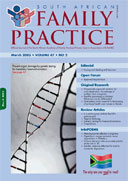Genetics in family practice: Preventing organ damage by genetic testing for hereditary haemochromatosis
Abstract
The rapid discovery of several iron-related genes in the last 10 years has led to the development of cost-effective genetic assays for early diagnosis of hereditary haemochromatosis (HH). A genetic predisposition for this relatively commontosomal recessive disease has been identified in approximately 1 in 100 South Africans of European descent. If left untreated, this condition may lead to organ damage presenting as cirrhosis, liver cancer, diabetes, arthritis, impotence, sterility and/or cardiac disease. Due to the fact that serum iron parameters are frequently affected by factors such as liver disease and inflammation, direct mutation detection has become the method of choice for accurate diagnosis of inherited iron overload in patients with elevated iron stores. Haemochromatosis can be prevented by regular blood donation or phlebotomy and therefore detection of a genetic predisposition at an early age, before irreversible damage to cardiac, hepatic and endocrine tissue occurs, represents an important clinical goal. (SA Fam Pract 2005;47(2): 44-45)
Published
2005-03-01
Section
Review Articles
By submitting manuscripts to SAFP, authors of original articles are assigning copyright to the South African Academy of Family Physicians. Copyright of review articles are assigned to the Publisher, Medpharm Publications (Pty) Ltd, unless otherwise specified. Authors may use their own work after publication without written permission, provided they acknowledge the original source. Individuals and academic institutions may freely copy and distribute articles published in SAFP for educational and research purposes without obtaining permission.

